
Janrudolph
Members-
Posts
252 -
Joined
-
Last visited
Content Type
Profiles
Forums
Events
Store
Downloads
Gallery
Everything posted by Janrudolph
-
Thank you so much, Piers and Florian! It seems first choice falls on the saihai kozuka. I think the only uncertainty I now have, is as to the probable age of that kozuka. What more can be said, besides that it is simply Edo? Early...late? Regards Johan
-
This pic show the reverse of the two kozuka. Small dent on the lower kozuka. Looking back at the top picture, the blade nakago of the lower kozuka is quite long and seems to belong to the kozuka, but I'm not sure of the top blade, whether it might have been exchanged. The bottom blade has a signature suggested to be "Seki Kanemoto", but the top blade signature is still unknown. If with my own arthritic fingers (!) I'm going to attempt the big job of crafting a super kiri box, which of these two kozuka is best deserving to get mounted? Regards Johan
-
Most of you will recognize the top design to be a saihai. The bottom one I have not identified yet. I need help with that, please.
-
Good day friends. I would like you to help me choose the best, most worthy kozuka out of the three I possess, in order to make a traditional kiri box for it. Please see pictures of two of these. (The third is certainly interesting, but unfortunately too damaged to consider.) Johan (More pics to come)
-
Thank you very much, Brian! Much appreciated. Regards Johan
-
So do you think one can tell from the pictures that they are edo or repro? Regards Johan
-
I tried having a friend look the menuki over with a hand-held XRF scanner, and he said they were mostly copper. I can only guess that might mean Shibuichi. So I am eager to ask if you guys think this pair might date back to Edo, or should I be satisfied they are a modern reproduction? I'm including a picture taken of the menuki turned around. My friend sounded quite knowledgeable when he said the little studs visible at the back showed them to be genuine. This pic brings the colour out much better. Regards Johan
-
Good day friends. I have been absent for some time, but not inactive regarding my much-researched katana! I have here a pair of menuki that the previous owner obtained at auction a while ago. It accompanied an Edo period iron tsuba signed "Echizen (no) Ju" and "Kinai Saku". I have both now, and I am entertaining the notion that the pair of menuki might also be Edo, especially since they and the tsuba were taken off the same katana. Let the pictures speak. Regards Johan
-
Home-made accessories for nihonto
Janrudolph replied to Janrudolph's topic in General Nihonto Related Discussion
Thee following pic shows the shirasaya that I drew my inspiration from. It is in the book War in the Pacific, and shows the shirasaya belonging to Gen Hideki Tojo, who you will know was Prime Minister and War Minister of Japan, WWII. At 40 cm long it is the largest photograph I could find with which to take measurements from, as I had no way of getting my hands on a real shirasaya to use as a model. -
Home-made accessories for nihonto
Janrudolph replied to Janrudolph's topic in General Nihonto Related Discussion
That's affirmative, Rich. I used what was left over of the poplar wood I procured for the shirasaya. In making the shirasaya, I thought of bringing in a small improvisation to serve as my signature feature, by adding the two dark brown spacers as a koiguchi and to lie next to the fuchi. I though the contrast would look nice. Shortly thereafter I chanced to see a nihonto in shirasaya having exactly the same two dark spacers as mine. And I thought I was being original! Johan -
Home-made accessories for nihonto
Janrudolph replied to Janrudolph's topic in General Nihonto Related Discussion
The top pic you will recognise as a double kiri box. I made it to hold and preserve my mini-collection of tsuba. Underneath there is a compartment for some documentation, with the purpose of identifying the tsuba for a viewer. The left one is a signed iron Echizen (no) Ju Kinai Saku, made by the 6th generation (rokudai) of the Takahashi family. The design is of a single aoi leaf and stalks. The tendrils are inlaid kin zogan. Clues point to this tsuba to have been made between 1809 and 1821. The one on the right is a nerikawa tachi tsuba with a classic aoi hollyhock-shape and inome sukashi (boar's eye openwork similar to a heart shape). On the single o-seppa there appears a motif repeated four times, bearing at each end an inome (representing vigilance, so I am led to believe). The o-seppa is shakudo and the cross motif is gold. I believe it was made sometime between 1800 to 1867. PLease consider when reading what I have said about the two tsuba, that I am not stating proven facts. But having read up extensively and hearing forumites' opinions, these are the only conclusions I can arrive at. In stating my views on these two tsuba, I am making it easy for any of you guys to voice your difference in opinion. Please do come in and comment - I have not stopped learning yet! Bottom pic: Forumites have suggested I should put my Nobuyoshi katana in shirasaya. Only way I could do that is to make it myself. I used poplar wood and spent seven weeks at my work bench trying my utmost to get the thing perfect. I am happy with the end result, but not so happy with what the constant repetitive handwork it took to make the shirasaya caused to my right hand: I developed painful carpal tunnel syndrome and a trigger finger. I might have to have it surgically fixed. But the shirasaya project is done! Of course I also had to make a wooden blade to hold the koshirae together, and the stand to exhibit the set. Regards. Johan -
Home-made accessories for nihonto
Janrudolph replied to Janrudolph's topic in General Nihonto Related Discussion
-
Good day friends. I would very much like to show you two pics. Please see below. Johan
-
Barry, looking at the last post you wrote made me realise I'm speaking to a big, big man. If I could, I'd call up Scotty to transport me magically to your place "down under" so I can have a beer with you and have the privilege of shaking your hand! In the meantime I have been busy looking for more nerikawa tsuba looking like mine, and I came upon these two (please see below). The first one looks like mine because of the utterly poor condition of the lacquer, however, mine also has the four boar's eye cutouts in addition; and the second because of the cross design which looks much the same as the silver (?) Art Museum tsuba and my tsuba's single o-seppa. The first one was posted in 2014 by a member called Jason, and the second by Boris Markhason, posted by Marius in that same year. The second one is said to date to the Momoyama to early Edo period (c. 1590-1650). It consists of four layers of leather which have been carved and assembled to mimic a classic aoi tachi tsuba with o-seppa. What about the first one's date? Well, Boris has said that the vast majority of preserved nerikawa tsuba date to the late Edo period. Edo is 1603 - 1867, so late Edo runs up to 1867. Now, I think what is plausible for the first one is plausible for mine too, so I think my nerikawa tsuba was crafted not later than 1800-1867. That makes it older than 153 years, but probably not older than 220 years. This time span could account for the deterioration in condition it suffered. I'd want to go for 220 years or older even, because I really do think that the level of deterioration I see is profound and genuine. Think I'm imagining things, you all? Well, shoot me down in flames with sound reasoning. Johan
-
Now on to Ian's reply. Further up in this thread I have shown pictures and I have described the "unworthy object" in some detail. It consists of a single-layered piece of hard, sturdy leather. I have examined the cut-through openings with a 10 X glass and found no lamination, also no delamination, also no sign of a layer of metal glued between layers of leather. I have already reacted to Brian's request that I examine the tsuba and o-seppa with a strong magnet, and I have found no attraction whatsoever. And finally, the o-seppa has just yesterday been examined by XRF analysis by a nuclear physicist contact of mine, who reports that the plate shows a profusion of copper with a smattering of gold and iron. In my book, that's shakudo. The cross is gold, with a smattering of copper. So Ian, does that perhaps sway your finding on the tsuba? I still can't place this object in the timeline of Japanese history, but it does not seem to be Meiji or later. If it should be a "modern rework", like Christianmalterre suggests, how come the short passage of time has wreaked such devastation to the condition of the leather and surrounding lacquer? Johan
-
Barry and Ian have thankfully climbed onto the wagon and I need to reply to both. However, I find myself faced with a problem. First of all, what Barry recommends cannot be done, not because I'm lazy or uncaring, but because everything concerning this blade and its koshirae has already been thrashed out in other threads. Barry has himself been a contributor to the thread where the blade was shown and discussed and I have already jotted down his take on the blade. The signature and dating mei was also shown and discussed in detail in a second thread. And the koshirae was similarly done in a third thread. So I have amassed a load of ideas, opinions, thoughts and misgivings throughout the run of these three threads. This has enabled me to combine the sum total of the contributions and compile a final wrap-up concerning the Nobuyoshi katana and its trappings. During the run of the threads I have responded to requests for further pics, and, after supplying same, no responses were forthcoming. So there does remain questions that I had, which sadly has to date not been replied to. I have also found that whereas forum members have been kind, considerate and helpful in the majority of cases, there have been instances where they do not scan back to earlier posts where facts and descriptions have been laid on the table, and consequently misjudge a situation. This is not me just complaining! I am just as guilty of human failings as we all are, so it's no train smash. I'm just trying to explain to Barry why I cannot react to his request, which means, if I should comply, that the whole caboodle repeats itself. And, Barry, the koshirae might look nice to you, but the forum members have poo-pooed it, saying that its "not Japanese" and "made yesterday". In fact, I have never to date seen such handachi fittings on any other sword. The handachi fittings I do see, all look like the fittings on my shin-gunto type 98 officer's katana.
-
Christianmalterre, whereas I am grateful that you have come in, I am not too convinced by what you have eloquently offered. I prefer somebody to dispute an opinion I have offered with some convincing alternative statements containing reason. 1) I did offer clear pictures. Looking at the leather tsuba I have in hand, and noting the expertise that must have gone into the laborious building up of black lacquer to give the tsuba a smooth surface and especially a raised edge, I get the opinion it could not have been palookas who crafted this object, nor do I think it was made by machines. These are Japanese craftsmen of old, is that not true? 2) You mention 70's to 80's. I take it you mean the dates to be from the end of the "last century". The last century was the 20th century, running through the 1900's. The time span suggested (1970 - 1980) means you think the tsuba is about 40-50 years old. I fail to see how a short span of time like that can wreak such devastation on a beautifully crafted tsuba as this must have been when new. (That's even if I acknowledge that time is cruel to leather.) 3) Please do me the kindness of describing to me, or showing a picture, of a "very old" nerikawa tsuba, or an "ancient pre-Edo" nerikawa, or even any of the "new model" nerikawa, and especially one of the "neuzeitlich gearbeitetets" tsuba. That would aid me tremendously in placing "my" tsuba in a time frame. 4) I'm very eager to learn from you, Christianmalterre, but your statements are not yet as helpful as I would like it, or I have been too slow to take in what you said. Please come back! Regards. Johan
-
Richard, thank you for coming in! I have come to be very much enlightened by all your contributions so far to my knowledge of this tsuba. At this stage, taking into account ALL that you have mentioned so far, it seems the opportune moment to tell you something of my Nobuyoshi katana's connection with this tsuba. 1) I got the blade plus koshirae from a SA guy. 2) This guy had the blade and koshirae renovated by various "service-providers". 3) The blade is signed Nobuyoshi and dated 1680. 4) The koshirae was judged by forum members to have been made "yesterday". 5) I thought the koshirae was untypical and so I did not like it. 6) Upon my request for information, the previous owner said the sword had the leather tsuba pictured above in place. He did not like that worn tsuba and fitted a replacement katana tsuba instead. 7) If you look at the fittings on the koshirae (see picture below), which he said were as he got it, you will agree it shouts "handachi"! Replace the silver tsuba with the nerikawa tsuba, and it completes the handachi image! This makes me wonder if I should not remove the silver tsuba, make a mock-up of the missing o-seppa as best I can, and fit the leather tsuba plus the two o-seppa to restore the original intention, namely that the koshirae was meant to be handachi. What say you all to this notion? Johan
-
Dale & Brian, thank you. Let me reply to Brian first: my strongest magnet shows no attraction whatsoever to any part of the tsuba or o-seppa. The way you asked the question convinces me you felt you can arrive at a clear conclusion depending on my answer. I'm eager to hear what that is, as this tsuba has whetted my appetite for clues as to its dim past! Dale, I've looked at the jpg link and the April 7, 2010 link that you supplied, for which I am grateful. The auction link set me on a search route that led me to information about a tsuba that currently resides in the Walters Art Museum, Baltimore. It looks surprisingly like "my" tsuba, however, I can't make out whether that tsuba is nerikawa - I think not. I also don't know if there are two o-seppa, or if the tsuba is a one-piece unit with decorations on it that simulates o-seppa. (I'll post that picture below.) But that is the ONLY picture I could find that looks at all like "my" tsuba. There are those that believe the gold cross design depicts a Christian motif, and others believe the cross is a representation of the ken motif repeated four times as in the four directions and bears at each terminal an inome (boar's eye) symbol which indicates vigilance and unwavering commitment. So if that is the explanation of the design of the Art Museum tsuba in the pic below, then it must also explain "my" tsuba. My further answers to Dale's questions are: (i) I cannot see any layers in the leather of my tsuba. Looking at its condition, one would think it would have started to delaminate, and it did not. (ii) There is definitely no fukurin. (iii) There's no gilding on the leather; it's only the lacquer reflecting light. (iv) I have only one o-seppa. I gather that nerikawa tsuba go back a long way, some even going back to the late Heian period. These early examples are usually marugata in shape and quite plain, being mostly supported on the sword by the o-seppa. This is not me being clever, it is what I'm reading. I'm not making any claims as to the nature or age of "my" tsuba. The picture below is the one in the Walters Art Museum. Johan
-
Good day to all! I have a leather tsuba with an accessory plate I believe to be an o-seppa. I also believe the cross-shaped pattern to be gold. Looking closely at the edge of the tsuba, I am not able to discern any layers of leather; it seems to one-piece. Please see the two pics below. I have found some rather confusing facts about these nerikawa tsuba, being really ancient (Heian period 794-1185) but also being made right up to the late Edo/Meiji periods. Simply put, the katana took over from the tachi, not so? So tachi style tsuba were not required to be made in later times? I realise the truth is not as simple, so please don't be too hard on me for being overly concise. How must I regard this latest find? Johan



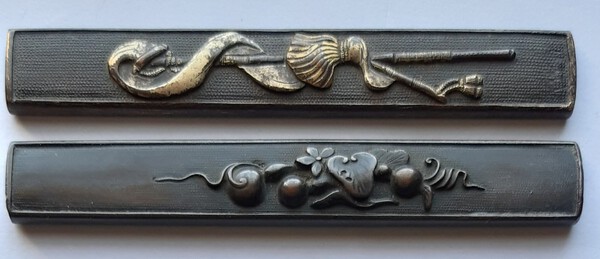

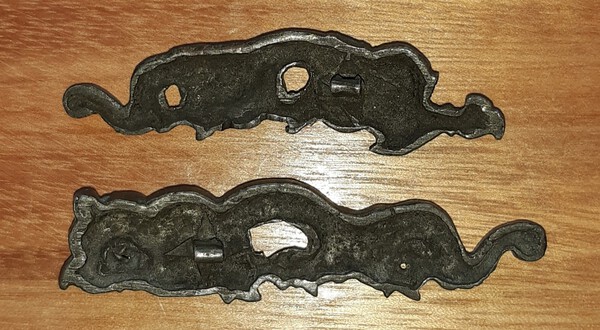

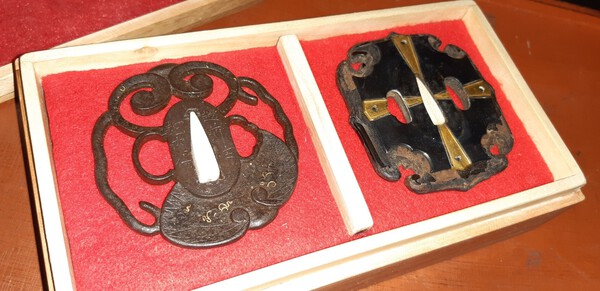
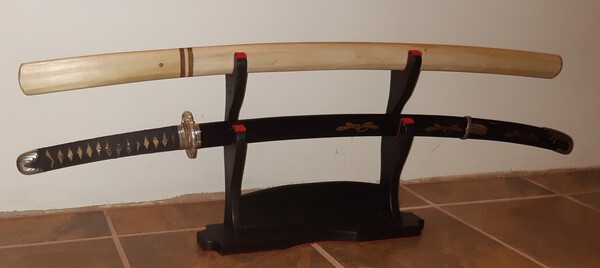

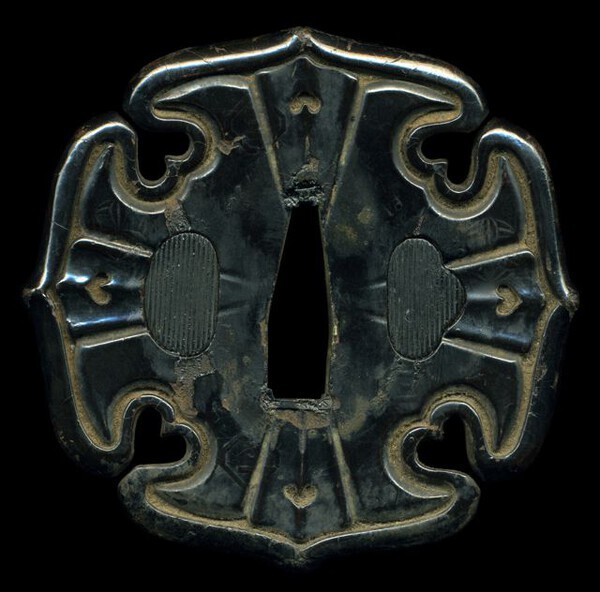

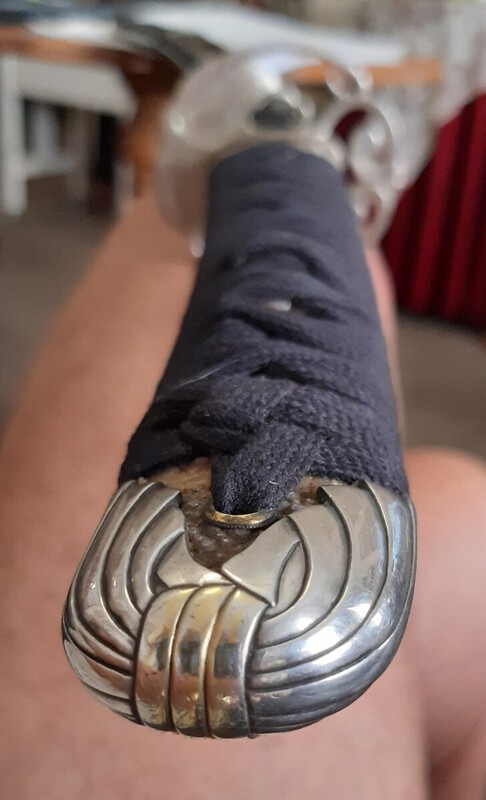





.thumb.jpg.aae3b9b8a7bc9fb53a4cc5e8dccbacb5.jpg)
